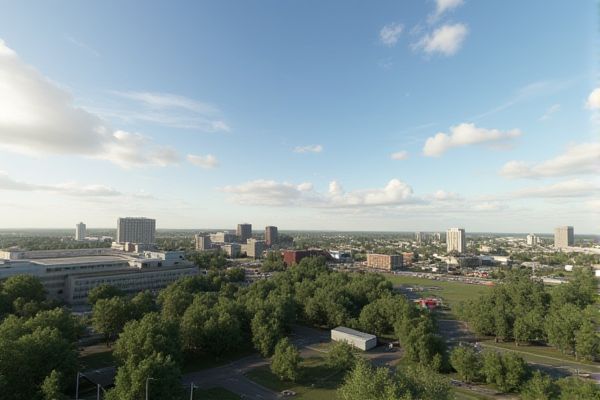
Cost of living in North Dakota: Affordable housing options. Low property taxes. Moderate utility costs. Reasonable transportation expenses. Variable grocery prices. Competitive healthcare costs. No state sales tax. Lower-than-average income taxes. Affordable childcare options. Entertainment and dining costs.
Affordable housing options
In North Dakota, affordable housing options encompass Section 8 Housing Choice Vouchers, public housing, and various other rental assistance programs. Eligibility for these programs is determined by factors such as income limits, citizenship, and additional criteria, with income thresholds varying from $26,050 for a one-person household to $54,150 for an eight-person household. The housing authorities are responsible for managing these programs and maintaining the waiting lists. For more detailed information, you can visit the Affordable Housing Hub where further insights about these options are provided.
Low property taxes
In North Dakota, the average effective property tax rate is 0.94%, which is slightly below the national average of 0.99%. Property taxes are calculated based on 4.5% of the market value of residential properties, making the state's property taxes relatively low. For more detailed insights on this, you can explore the North Dakota Property Tax Calculator provided by SmartAsset.
Moderate utility costs
In North Dakota, utility costs are moderate, with residents paying around $320 per month for basic utilities like electricity, heating, cooling, water, and garbage, which is close to or below the national average. The average electricity bill is approximately $117 per month, and water bills are notably low at $24 per month. For more detailed insights into these expenses, you can visit the Rent.com Blog where they provide a comprehensive overview of the cost of living in this region.
Reasonable transportation expenses
Transportation costs in North Dakota are relatively low, with some cities like Grand Forks being 4.1 percent below the national average, and public transportation options available in all counties, making it easier and more affordable to get around. For more detailed information, you can visit the Cost of Living in North Dakota guide. This accessibility contributes significantly to the overall livability and affordability of the state.
Variable grocery prices
In North Dakota, the landscape of grocery pricing presents a diverse range, further influenced by underlying economic and demographic factors. The state ranks 25th in the nation, with the average weekly grocery cost calculated at $265.11. Interestingly, despite this ranking, North Dakota boasts the lowest grocery index in the country, registering at 94.2, which is an impressive 15.8% below the national average, making it one of the most wallet-friendly states for purchasing groceries. Variations in prices are particularly noticeable across different regions; for instance, rural areas tend to offer more budget-friendly options. This stands in contrast to higher-end stores found in more populous districts like Cass and Burleigh Counties, which cater to a diverse array of economic backgrounds. Further insight into the dynamics of local markets is explored in the article on Grocery Store Dynamics in North Dakota, revealing how the state's geographic and socio-economic diversity impacts consumer choices across its regions.
Competitive healthcare costs
Healthcare services in North Dakota cost 11% higher than the national average, despite the overall cost of living being 5% lower than the national average. For more detailed insights, you can explore the Cost of Living Calculator provided by RentCafe to understand how various expenses in North Dakota compare to the rest of the United States.
No state sales tax
North Dakota does impose a state sales tax, with a base rate of 5% for most retail sales, ensuring that there is always a minimum taxation on sales. In addition to this, local taxes can be added, causing the total sales tax to range from 5% to 8.5% depending on the location. For more details and specifics on these rates and their applications, you can visit the official North Dakota Office of State Tax Commissioner through the Sales and Use Tax page where comprehensive information is available.
Lower-than-average income taxes
North Dakota boasts lower-than-average income taxes, with rates ranging from 0% to 2.50%, and no local income taxes. The state's income tax system includes three brackets, with income up to $51,650 exempt from state income tax for single filers, and higher thresholds for married filers and heads of household. For more detailed information about these tax rates and how they impact your earnings, you can visit the North Dakota Paycheck Calculator on SmartAsset.
Affordable childcare options
In North Dakota, families struggle with the high cost of child care, which can be as expensive as in-state tuition at a public university. The state lacks sufficient affordable childcare options, with a significant gap between demand and available slots. A major issue is that child care businesses often operate on narrow margins, exacerbated by high staff turnover and low wages for workers. For more detailed information on this pressing issue, please visit ND Kids Count for insights on how North Dakota can make child care both affordable and accessible.
Entertainment and dining costs
Entertainment and dining costs in North Dakota are generally lower than in many other states. For example, a basic meal with a drink at an inexpensive restaurant costs around $23.75, and a fast food combo meal is approximately $11.93. Other entertainment expenses, such as movie tickets and gym memberships, also remain relatively affordable. For further insights into the cost of living in North Dakota, you can visit the Unbiased website, which provides a comprehensive overview of various expenses in this state.
